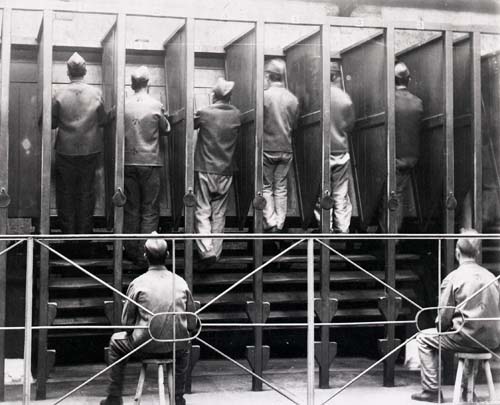3 The Fenwick Committee
Nationalisation provided an opportunity to achieve uniformity in prison discipline in local prisons. In England and Wales, uniformity was pursued with a particular ruthlessness by the chair of the Prison Commission, Sir Edmund Du Cane.
The rules and regulations in the 1865 Prison Act were enforced in every prison. Many of these rules were too general, so committees were established to decide on the minutiae of prison discipline. A committee on hard labour decided that prisoners should climb 8,640 feet on the treadwheel each day (the equivalent of climbing the steps to the top of the Shard in London 8 times) to meet the requirements of their sentence. Another committee devised a penal diet that would sustain life but was repulsive enough to deny prisoners any pleasure in eating. Activities had to be quantifiable to enable uniform implementation. As such, uniformity encouraged severity rather than leniency (McConville, 1995b, pp. 130–3).

In 1879, the Prison Commissioners for England and Wales recommended the appointment of a departmental committee (a committee initiated within a government department) to devise a uniform scheme for the provision of education in local prisons. Three committee members were appointed: Captain W.H. Fenwick, an inspector employed by the Prison Commission; the Rev. George de Renzi, chaplain at Pentonville Prison; and the Rev. T. W. Sharpe, a senior inspector of schools and inspector of training colleges for schoolmasters.
The committee operated under a tight set of terms determined by the chair of the Prison Commissioners, Sir Edmund Du Cane. Between April and June 1879, committee members visited prisons to obtain details on existing schemes and to observe the teaching of prisoners. On 14 June, they presented a draft scheme to the Home Secretary. It was approved for trial in a select number of prisons. In 1883, the scheme (known as the Fenwick scheme) was rolled out to all remaining local prisons in England and Wales via a Standing Order from the Prison Commissioners.
Activity 3 Educational Instruction of Prisoners in Local Prisons in England and Wales, 1883
Below is a summary of the main features of the Fenwick scheme. Read it now and consider the following questions:
- The primary aim of this scheme was to achieve uniformity in the provision of education in local prisons: no prisoner would receive less or more education because of the prison he or she was sent to. Can you see any loopholes which could be exploited by prison officials to expand or contract provision at their institution?
- Was attendance at school voluntary or compulsory in this scheme?
- In Session 3, you learned that the primary aim of prison education during the early 1800s was evangelisation: teaching prisoners to read and write enabled them to engage with the Bible. What was the aim of this scheme?
Summary of the Fenwick Scheme for the Instruction of Prisoners in Local Prisons
- Prisoners sentenced to at least four months imprisonment were to be examined by the chaplain and placed in one of three classes:
- a.Class I, those who could not read Standard I of the National Society’s reading book (that is, to read a short paragraph from a book not confined to words of one syllable);
- b.Class II, those who could read Standard I, but had not passed Standard II (that is, to read a short paragraph from an elementary reading book);
- c.Class III, those who had passed Standard III (that is, to read a short paragraph from a more advanced book).
- Prisoners in Class III should not receive instruction except in writing and arithmetic should they need it. They should, however, be given authorised books and a slate and pencil.
- Prisoners in Class II should receive 15 minutes of individual tuition in their cells twice a week.
- Prisoners in Class I should receive instruction in reading in classes for 30 minutes twice a week, and instruction in writing and arithmetic in their cells for 15 minutes twice a week.
- Prisoners should receive instruction in: reading as far as Standard III inclusive; writing, as far as transcribing a portion of the book read, and reading what has been transcribed; arithmetic, as far as casting simple money accounts, and mental calculation of small money sums.
- Prisoners aged 40 or above should not receive instruction, except in special cases, recommended by the chaplain, and approved by the governor. Prisoners identified by the chaplain as having no capacity for instruction shall be excluded. Prisoners who are idle shall be temporarily excluded. Chaplains should exercise discretion in excluding prisoners with previous convictions.
- Prisoners should not be given library books until they can read Standard II with fluency.
- All juveniles under 16 years of age should receive instruction for one hour daily in class.
Discussion
- You might have noticed that several loopholes existed in the criteria for eligibility. Chaplains and governors were given power to include prisoners aged over 40, and to exclude those who they believed had ‘no capacity’ for instruction. The Standing Order suggested that chaplains might also exclude those with previous convictions.
- This was a compulsory scheme. All prisoners with sentences of at least four months’ imprisonment who could not pass Standard III were enrolled in school, unless they were aged over 40 or were deemed to have no capacity for learning. Prisoners could not get out of school by being idle – those who were idle were only temporarily excluded, so as not to reward their bad behaviour. These rules sat awkwardly beside those of the system of progressive stages – you looked at these above – which positioned schooling as a privilege to be earned.
- The primary aim of this scheme was to raise the literacy and numeracy of prisoners to a basic level of competence.
